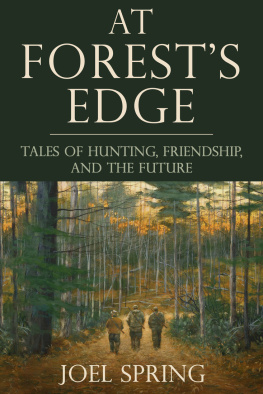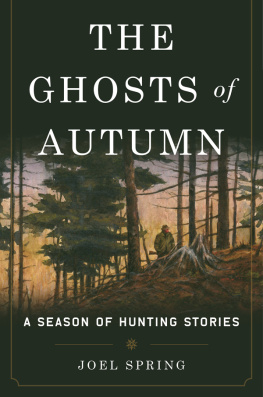Postscript

T he Wild Branch flows swiftly between brown and tan rocks. It spreads out and glides more slowly past low sand-and-cobble stretches lined with aspens and alders. Were hunting among those fringing bands of trees, Dave, Winston, and I.
I am pleased at how quickly I have met fellow bird hunters in Vermontand at how generously they have shared their coverts with me, in this, my first autumn in the north.
Ive also hunted by myself in the old reverting fields around our house, among twinkling gold aspens, brilliant orange and yellow sugar maples, burnished tamaracks, and deep green spruces, cedars, and pines. Caillie and I have flushed woodcock in the low areas, and grouse in the hills.
Right now, theres a grouse weighing down my game pouch, a plump gray-phase male. Caillie flushed the grouse, which alighted for a moment in a tall aspen: as the bird launched himself from the branch, my shot tumbled him. Im carrying my tried-and-true bramble divider, the Jeffery 20 gauge. Im glad I made the shot, because I didnt get to practice with the gun very much over the summer, what with doing carpentry work. But the old house is nice and snug now, and two woodstoves are in place and six cords of hardwood lie stacked in the shed.
Were almost back to where we started working the covert. Apparently Dave and Winston have decided that the days hunting is over: Theyre up on the bank to my left, behind a screen of trees, walking along on the edge of a hayfield, where I can hear their voices. Im down next to the stream, keeping to the sandy areas where the going is quiet.
I catch a flash of white: Caillie slips through the alders just below the lip of the hayfield.
The grouse comes hurtling out of the low trees. Seeing me, it banks to its left and heads across the creek. My shot catches it when its directly above the Wild Branch. The birds head falls and its wings tuck back against its sides and its momentum carries it across the water. The grouse falls in the grass on the far side.
Caillie emerges from the alders. She runs over to me. I sit her down with a pip on the whistle. I put my hand in front of her nose, with my fingers pointed toward the fallen grouse. I move my hand like an arrow in the direction of the fall.
I release her: Caillie!
She wades into the creek and starts swimming. The line I gave her puts her downwind of the grouse; as soon as she climbs onto the far bank, she turns into the wind, catches the scent, and dives into the grass. She picks up the bird, then turns and trots down to the Wild Branch and swims back across.
Good girl, I tell her, as she comes out of the stream, the water dripping off her belly, darkening the rocks. Her eyes are on mine. She lays the grouse in my hand.
Chapter 1

I click the shotgun shut. The spaniel sits, her tail lashing, her eyes on the still-green stalks of goldenrod, the rank weeds, the tangled blackberry canes and thornapple stems. I speak her name: Caillie. She does not turn her head. So we wait; on my part, with excitement building, and also with annoyance, which, taking a deep breath, I work to overcome.
Caillie. Still nothing, so I pip on the whistle, and at this she finally gives me her attention. Her eyes meet mine. Before she can abandon me again, I say Hunt em up! and, with a wave of my hand, signal to one side. She dashes off in that direction, charging into the brush.
I follow. Its astonishing, how quickly the sense of pure anticipation returns. It builds from my listening intently for the sound of a gamebirds wings. It comes from keeping a soft focus at the edge of my vision, ready to detect sudden motion, while concentrating a predators hard focus out in front, alert for a hitch in the dogs movements as she takes scent, or for a grouse or a woodcock launching itself from the ground. Anticipation also arises out of the memories of hunts past.
Caillie and I are entering the first covert of the year, and already I can feel myself returning to that welcome state of immersionin this moment, this place, this hunt.
I have taken only a dozen steps before Caillie is too far out in front: if a bird were to flush just a few feet ahead of her, I would not have a shot at it. I pip on the whistle, a single sharp note. I am pleased to see her hupsit down, in the parlance of those who hunt behind spanielseven if she does not then turn her head and look at me.
It is tempting to believe that once you have trained a dog, all you need to do is put her down in game cover and she will take up where she left off at last seasons end. I know it doesnt work that way, and I know Ill be spending the first few hunts this year conducting schooling that I should have taken care of during the summer. I decide to let Caillie sit for a while and calm down; better yet, she should sit at my feet. I blow a series of staccato pips, and back she comes, reeled in by the whistle. Another single pip, and she hups.
Still not looking in my direction.
I wonder what she thinks of me, this submissive yet willful bitch, who is fast and agile, whose legs are longer and slimmer than any spaniels need be. What am I? A slow, staring, tottering biped, tyrannical to boot? Sometimes my shotgun provides a bird to retrieve, but not often enough. Does she consider me an impediment to her own hunting? Theres a bit of a disconnect here, or perhaps a connection incompletely made. Its a situation that I have lived with for a long time and will continue working to overcome, because I need this dog, and I love her, albeit differently than I loved my first springer, Jenny, dead now for almost a year.
We wait.
Caillie looks searchingly into the brush and continues to pay me little heed. I glance ahead. The covert is shaped like an oversized football field, a long, lopsided rectangle whose far end is just visible from where I stand. This plot of ground is walled in on all four sides by trees: weedy red maples, twisted black locusts, here and there a tall, upright red oak or a shagbark hickory standing like a solid citizen among the rabble. The trees still hold onto their leaves. The maples leaves are the brightest and the most various: a mixture of reds, oranges, and yellows, overlaid on green. The locusts filigreed foliage is a wan yellow. Hickory leaves shine a rich yellow, like candle flame, while oak leaves remain a deep, glossy green. The saw-toothed compound leaves of sumacs burn a brilliant orange beneath the shrubs fuzzy maroon seed bobs. The crabapples jagged-edged leaves are a dull and mottled greenish yellow. Its hard to believe, but this disheveled, overgrown place was once a farm.
I remember some excellent hunts in this covert. I recall finding it, almost thirty years ago. It was a brilliant late October day. Three of us put an aluminum canoe into Bald Eagle Creek near the elementary school. We scraped through the shallows and paddled through the deadwaters, stopping here and there to check out prospective game covertslogging cuts, tangles of streamside alders, abandoned fields reverting to brush. Aspens grew in the old fields, and seedling pines, and crabapples scarcely taller than a mans head. I remember shooting at a grouse not far from where I now stand. I had no dog back then to give me advance warning; grouse in their noisy flight tended to startle rather than galvanize me; and I was an untrained wingshot. In those days, when I pulled the trigger it was rare indeed for a fleeing bird to come a cropper and fall out of that vast expanse of air. I can still see the way the grouse seemingly materialized from the open, leaf-scattered ground beneath a crabapple. On thundering wings it dodged upward through the crooked branches, its cream-colored breast flashing against the sky as it banked to cross the creek. Nowadays, I probably would kill that bird at the top of its rise. On that day more than a quarter of a century ago, I got off two tardy, futile shotsthen consoled myself with the fact that at least I hadnt stood there gawking. Observing the birds line of flight, Id watched it vanish into more good-looking cover on the creeks opposite bank.













